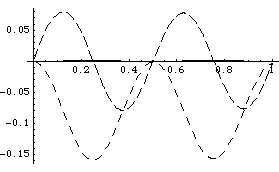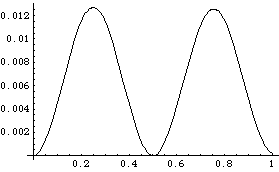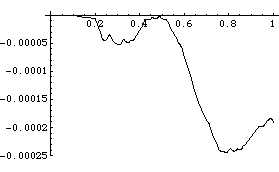10.4.5 Free ResponseTo find the unconstrained motion of the gyroscope, a FreeSystem object is built that contains a new set of equations of motion with constraints 2, 4, and 6 dropped from the model. Constraint 6, the constraint that locks the rotation of the rotor to that of the gimbal, is dropped in this simulation because the gross motion of the rotor results in some relative angular acceleration between these two bodies. If constraint 6 was not dropped, the model would represent an enforced constant angular velocity between the rotor and the gimbal, as if the rotor had a constant velocity motor attaching it to the gimbal.
The constant moment that was applied to the base is retained, so the model is expected to gain energy with the passage of time. This drops the constraints that lock the three rotational axes of the gyroscope. This integrates the FreeSystem object from T = 0 to T = endt. The MakeRules option includes the velocity solution in the result. Here is a plot of the three components of the angular velocity of the gimbal. The Z component is simply oscillating about zero, so the applied torque is producing no net motion of the gimbal. The Y component, however, is consistently negative, so the gimbal is precessing in an oscillatory manner.

Out[23]= |  |
Here is a plot of the rotation angle of the base.

Out[24]= |  |
Note that the Rotation function was not used in the preceding example to resolve the rotation angle of the base from the Euler parameters, but ProjectedAngle was used instead. This was done because the small numerical errors in the integration caused one of the Euler parameters to drift slightly above 1.0. The Euler parameters are not meaningful for absolute values greater than 1, so the Rotation function would return an error. The ProjectedAngle function uses vector algebra, instead of a mathematical identity, and it does not care if the values of the Euler parameters stray above 1.
Since the gyroscope model is a conservative system (if the applied moment is recognized as a conservative force) the sum of the kinetic and potential energy in the model should be constant. The potential energy stored by the constant applied moment is the work done by the gyroscope on the applied moment, which is the negative of the magnitude of the applied moment times the is rotation of the base. The following plot shows that the numerical error in the integration has allowed the total energy of the model to decrease by about 2% of the maximum kinetic energy over the integration period. Here is the total energy in the gyroscope, including the energy stored in the constant applied moment.

Out[25]= |  |
This is near to the maximum kinetic energy of the body.
Out[26]= |  |
Tightening the error budget by a factor of 10 with MaxError -> 0.00001 will reduce the total energy rise to only 0.12% over the same period, with an associated increase in run time. Using the ConstraintCorrection -> True option, with the default error budget, will have virtually no effect on the error in the total energy. This is because the error stems from the deviation in the Euler parameters that are very close to 1, an error on which constraint correction has little effect. Using the FitDegree -> Quartic option, with the default error budget, will reduce the total energy rise to 0.71%, with only a small increase in run time.
|